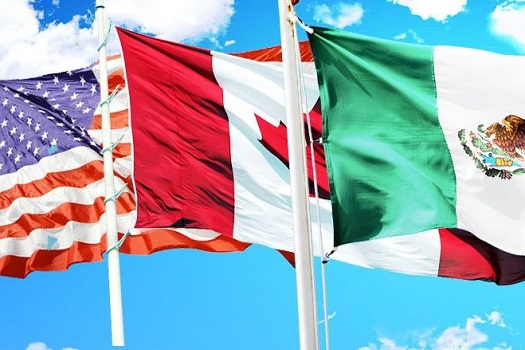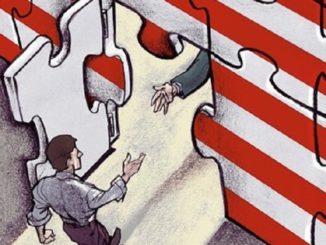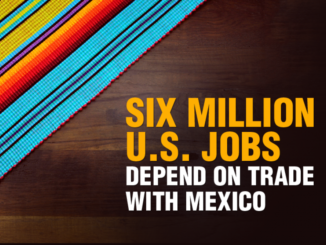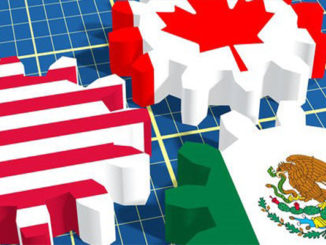
by Simon Lester and Inu Manak
President Donald Trump’s biggest trade initiative so far, the North American Free Trade Agreement renegotiation, begins this week. The administration’s objectives are vague, and the outcome is uncertain, both in terms of timing and content.
Nonetheless, despite some very aggressive anti-trade rhetoric during the campaign (Trump called NAFTA “the worst trade deal in history”), this renegotiation has the potential to improve NAFTA, which lacks the innovations of more recent trade agreements.
The NAFTA renegotiation will not simply be a presidential wish list. Free traders, rather than cowering in fear, should use the renegotiation to modernize NAFTA and try to extend the liberalization process it began 23 years ago.
In doing so, we must keep in mind that NAFTA has brought great benefits to all three countries — the United States, Mexico and Canada — and these achievements should not be rolled back. Currently, Canada and Mexico are the destination for 34 percent of all U.S. exports, and the U.S. remains the largest single source of foreign direct investment into both countries. Despite what its critics claim about job losses, a 2016 report by the U.S. International Trade Commission stated that NAFTA has had “a small increase in U.S. welfare” and “little to no change in U.S. aggregate employment.”
There are three main ways that NAFTA can be improved. First, NAFTA came into force when Facebook CEO Mark Zuckerberg was nine years old, and does not address many of the e-commerce issues that are now central to international trade. Over the years, the United States has developed increasingly sophisticated provisions on e-commerce in other free trade agreements, culminating in the Trans-Pacific Partnership (from which Trump withdrew). As part of the NAFTA renegotiation, e-commerce provisions can be further updated to make NAFTA cutting-edge in this area.
Second, over the past couple of decades as NAFTA has been implemented, some flaws have been exposed. For example, the core dispute provision (Chapter 20), which lets governments bring complaints when they believe another government is violating the rules, has not functioned. Defending governments have sometimes been able to prevent complaints against them, as in a 2000 case brought by Mexico against U.S. barriers to sugar, which never made it to the panel stage after the U.S. blocked the process. New rules are needed in this area to ensure that complaints are heard.
Two other specialized dispute procedures on investment rules (Chapter 11) and review of anti-dumping countervailing duties (Chapter 19), could use another look as well, and possibly some amendments, as these provisions have raised concerns about the proper role of international courts and the balance between international and domestic power. The three governments should conduct a review of these provisions to see whether they are the most effective means for achieving their stated objectives, as conditions have changed over the years.
Third, NAFTA got rid of tariffs on most goods, but there were a few exceptions. One of the most notorious is Canada’s supply management system for dairy, poultry and eggs, which was excluded from the original negotiations because of pressure from domestic industry. The renegotiation effort could and should address these protectionist barriers. In addition, services markets were barely touched in NAFTA, and there is now an opportunity to tackle longstanding barriers in telecommunications and broadcasting, and open up additional sectors that NAFTA could not anticipate at the time, including those in which online trade is now possible, such as education or health.
At the same time, we must be wary of someone injecting the poison pill of protectionism into the new NAFTA. For instance, there has been talk by some people in the Trump administration of a trade deficit renegotiation “trigger,” under which NAFTA could be reopened if a government saw its trade deficit increase after signing. This is a dangerous idea. Most economists agree that the causes of trade deficits are complex, and generally reflect macroeconomic factors rather than trade agreement provisions. U.S. trading partners are unlikely to agree to such a provision, and the U.S. Congress should reject it as well.
Furthermore, other proposals, such as changing government procurement rules to allow the expanded use of “Buy America” provisions would also be a step backwards for liberalization. “Buy America” policies may strike an emotional chord with some voters, but are nothing but a traditional protectionist market distortion, limiting competition and raising costs for these projects, and leading to our trading partners adopting similar policies that harm U.S. goods and services providers.
The administration has also mentioned strengthening rules of origin, which are the requirements that determine whether a product qualifies for duty free entry. NAFTA rules of origin are known to already be the most stringent of any trade agreement in the world. Strengthening them denies the reality of international trade today, where things are not just “made in” one place. In fact, 15 percent of U.S. exports contain foreign content, and this figure has been increasing over time
This week, the Trump administration has the chance to begin a constructive renegotiation that would enhance North American liberalization and competitiveness, by tackling the remaining barriers to trade and investment on this continent. They should not waste this great opportunity.
Simon Lester is a trade policy analyst at the Cato Institute. Inu Manak is a visiting fellow at the Cato Institute.



